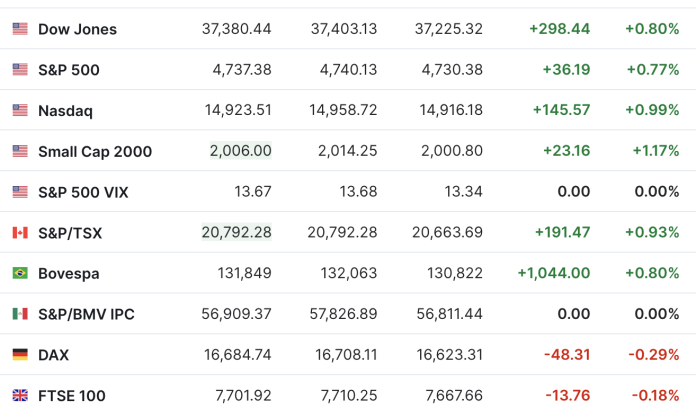Source: Investing.com Indices for Global Markets December 2023
As we enter 2024, the financial market continues to offer a diverse array of tradable instruments, each with unique characteristics and applications. From the seasoned Canadian investor to the curious newbie, understanding these instruments is crucial for navigating the complex trading world. This article aims to demystify these financial tools, offering insights into their nature and how they function in the market.
The Landscape of Financial Instruments
In the dynamic world of financial trading, various instruments offer unique opportunities and challenges. As we navigate through 2024, it’s crucial to understand these tools, each serving distinct purposes in the investment and trading arenas. Let’s kick things off with the most popular instruments of all – stocks!
Stocks
Stocks, or equities, represent ownership shares in corporations. When you buy a stock, you acquire a portion of the company, gaining rights to dividends and, in many cases, voting privileges. Many factors, including company earnings, market trends, and economic indicators, influence stock performance. They’re a cornerstone of most investment portfolios, offering potential for both growth and income.
Indices
Indices or indexes, such as the S&P 500 or the Dow Jones Industrial Average (DJIA), track the performance of a selected group of stocks representing a particular market or a sector of the economy. They serve as important benchmarks for gauging the health of financial markets and are used by investors to assess the performance of their portfolios.
Indices can be traded through index funds or exchange-traded funds (ETFs) and CFD indexes, offering exposure to a broad market segment with a single investment.
Index trading offers a streamlined way to engage with financial markets, enabling traders to gain exposure to a broad spectrum of assets without the complexity of investing in individual stocks, bonds, or commodities. It involves trading index-linked funds or share baskets that mirror key stock indices’ performance.
These indices are essential in reflecting the health of broader markets, including various industries, sectors, countries, or growth rates. For example, the S&P 500 represents the 500 largest companies in the U.S., while the Euronext 100 includes major European companies.
These indices guide fund managers in evaluating their portfolio performance and form the basis for passive index-linked funds and associated derivatives. ETFs, in particular, have become popular for their low fees and ease of trading, offering flexibility and quick access to stock indices markets. Indices are calculated using various methods, including simple averages or weighted averages based on price or market capitalization.
Price-weighted indices like the Dow Jones Industrial Average and Nikkei 225 give more importance to higher-priced stocks, whereas market capitalization-weighted indices like the Nasdaq 100 consider company size, making larger firms more influential in the index’s value.
Bonds
Bonds are debt instruments corporations, municipalities, or governments use to raise capital. When a trader ‘buys’ a bond, that trader is lending money to the issuer in exchange for ‘periodic interest payments’ as well as the return of the bond’s face value once it matures. They are generally considered lower risk than stocks, providing a steady stream of income and making them a staple in conservative investment strategies.
Commodities
Commodities include natural resources and agricultural products like oil, gold, and wheat. Trading in commodities can be done through futures contracts on exchanges, allowing investors to speculate on price movements without physically owning the commodity. Commodity prices are influenced by supply and demand dynamics, geopolitical events, and global economic trends, offering a way to diversify and hedge against inflation.
Forex
The foreign exchange market (Forex) is where currencies are traded. It’s the world’s largest and most liquid market, operating 24 hours a day. Forex trading involves buying one currency while selling another based on predictions of currency value fluctuations. Factors influencing these fluctuations include interest rates, economic stability, and global events, making forex trading potentially lucrative and highly risky.
This dynamic nature of forex markets demands a deep understanding of global economies and the ability to respond quickly to market changes. Traders in this market capitalize on the volatility of currency exchange rates, often employing strategies that require a keen eye for economic indicators and geopolitical developments.
As such, forex trading is a platform for seasoned financial experts and a challenging arena for aspiring traders looking to diversify their investment portfolios.
CFD-Style Derivative Instruments
Contracts for Difference (CFDs) are a popular form of derivative trading, allowing traders to speculate on the rising or falling prices of fast-moving global financial markets. With CFDs, traders don’t own the underlying asset but trade on the price movement.
They offer the flexibility to go long or short and are leveraged products, meaning gains and losses can exceed deposits. CFD trading requires an understanding of market dynamics and risk management and often suits experienced traders.
Each of these financial instruments plays a vital role in the global and Canadian economies, offering varied levels of risk and return. As we progress through 2024, staying informed and adaptable is key to navigating these markets effectively.
Concluding Remarks
As 2024 unfolds, the world of financial trading continues to evolve, presenting a myriad of instruments, each with its distinct role in the global economy. Each instrument offers unique opportunities and challenges, from stocks to bonds, commodities, indices, forex, and CFD-style derivatives.
For both the experienced trader and the newcomer in Maple Country, understanding these tools is more than just a matter of financial literacy; it’s a journey into the global economy’s heart. Whether aiming for growth through equities, stability through bonds, or diversification through commodities and indices, the key lies in informed decision-making and adaptability.
Forex and CFD trading, while more complex, opens doors to dynamic market strategies. As we navigate these diverse financial landscapes, our success hinges on our ability to stay informed, flexible, and responsive to the ever-changing tides of the financial markets.












